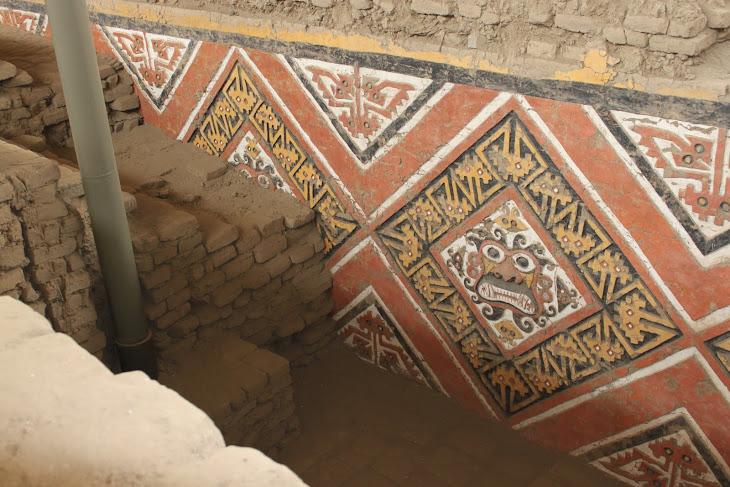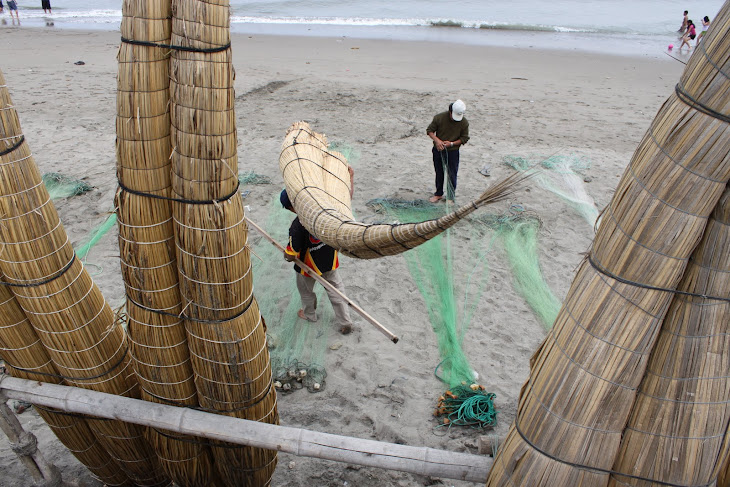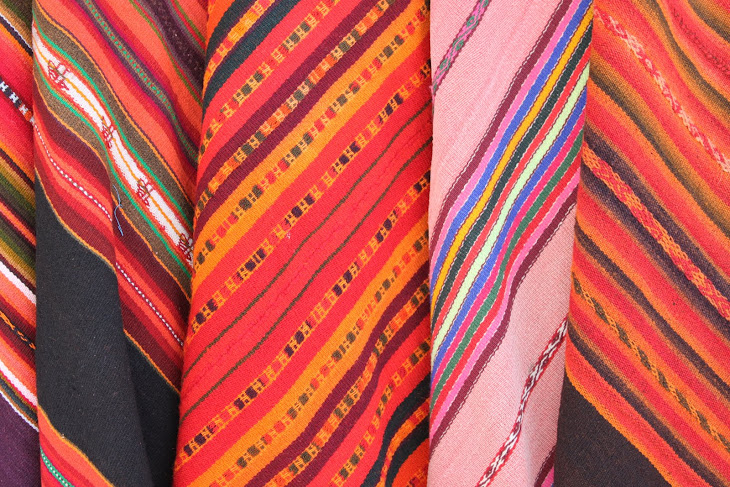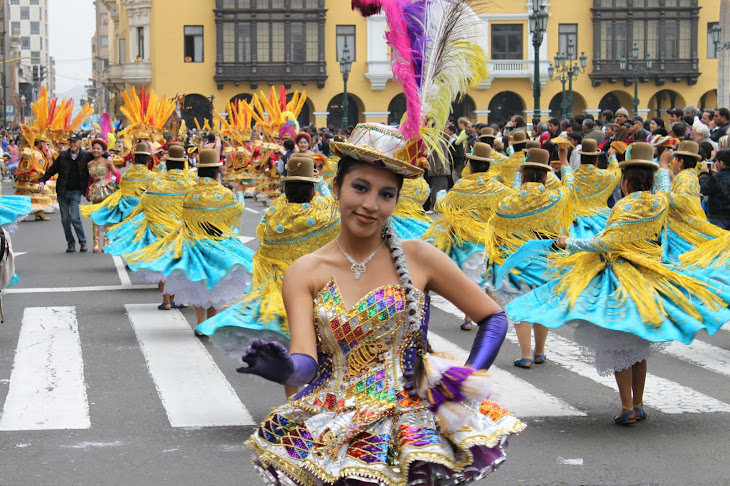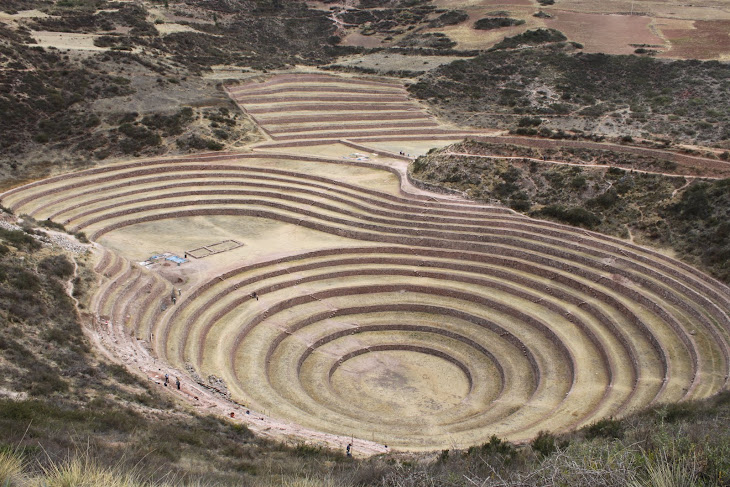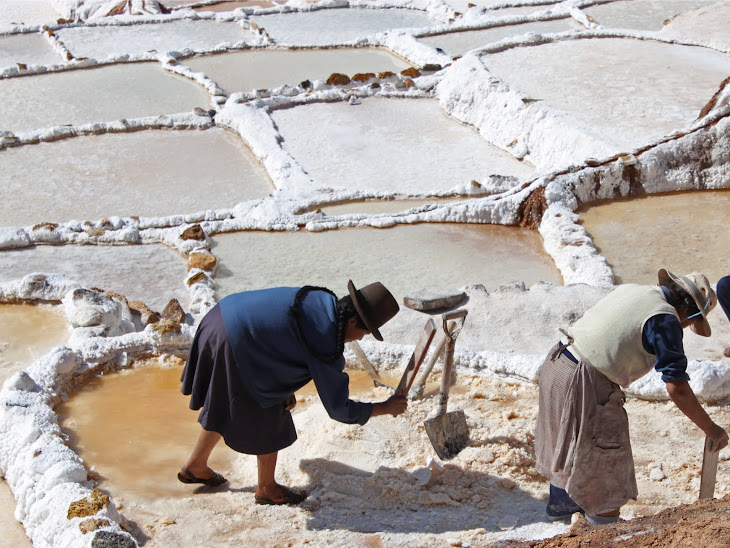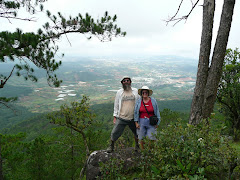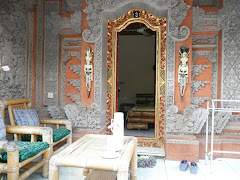Tuesday, September 7, 2010
ch-ch-ch-changes -- I can hear Bowie in my mind
We kinda knew reverse culture shock was going to be bad. Yup. It was. Still is. I (Bob) just got finished questioning the site foreman for the street-wrecking crew lazing in front of our house. I was tasked with ensuring our landscape rocks were set aside for re-installation after the city's workers tear out and replace the sidewalks. The contrast between that in-my-home conversation and the 11 months of fulfilled wanderlust, well, it's left me flummoxed. No time today. Gotta go to work. See. Culture shock. Watch for our best Peru pictures . . . next post.
Tuesday, August 3, 2010
Soft landing in L.A.
After 33 hours in transit, we arrived dazed and confused at LAX on Saturday afternoon. That was the longest Saturday ever, but we're beginning to feel more human again after lots of sleep, short walks in the neighbourhood and good home cooking (thanks Deni and Cynthia). One more flight to go, for a total of 31 over 11 months. Not to mention all the other forms of transportation we've taken. More boats than usual, which is not too surprising considering the number of islands we've visited, but more surprisingly, nothing resulting in seasickness. Bob does not fit in southeast Asian buses, but there was often no other option, so we became adept at snagging a seat with optimal legroom. We took just one train -- from Hanoi to Lao Cai for our visit to the northern hilltribes near Sapa. It just seemed the few trains didn't go the same route we wanted to take. I can't wait to sleep in my own bed. We've stayed in a wide variety of accommodations, ranging from the bungalow on the beach in Than Sadet, Koh Phangan, southern Thailand, for $13 a night, or the homestay with a family in Ubud, Bali, Indonesia, for $10 a night, to the big splurge with the overwater bungalow in Moorea, French Polynesia. I don't remember how much that one cost, but we calculated at the time that four days there cost the same as a month in Peru. I can't wait to cook in my own kitchen again, much as this has been a gastronomic adventure as well. We were surprised by the quality of the cuisine in Peru, amazed by the awesome tuna at Easter Island and enjoyed fresh fish and seafood almost everywhere. We savoured fine wines in Chile, New Zealand and Australia and sampled the local firewater, with mixed results. We rarely tried wine after reaching Asia in January because it was always stored in ridiculously hot temperatures that massacred the vino. Even the Two-Buck Chuck wine (from L.A's Trader Joe's) tastes better than anything pulled off the shelf in Asia, no matter how exhalted its provenance. Everything about L.A. immediately let us know that we were back in the North American culture: the differences from Europe are mildly amusing; the differences from Asia are profound. Much as we always enjoy going to Europe and after having immersed ourselves into Asia for half our tour, the return to North America has left us all tingly inside. It'll probably be another jolt when we finally get back to Canada. We can't wait for that last exciting hit of (reverse) culture shock.
Thursday, July 29, 2010
Final days
We returned to Hanoi yesterday from Halong Bay, which was an excellent choice for the final scenic location after an 11-month journey. We spent a night on a sailing junk, but none of the hundreds of boats just like it used their sails. Lovely night though, up on the top deck looking at the silhouettes of all those oddly shaped islands lit by a cloud-filtered full moon. That night was followed by three nights in a fancy bungalow on an often empty beach on Monkey Island. It was worth waiting the extra few days for the latest typhoon to pass by, as the sailing was acceptably calm. Although the tour was pricey by Vietnam standards, it met our criteria for beautiful vistas, secluded beaches and sunny weather. Maybe a bit too much sunny weather, but hopefully Karen's sunburnt face will have recovered by the time we get home. We did tire of having the same menu every day (most tourists stay one night), even if it was tasty barbecue and seafood. Didn't much care for the breakfast of cold fried eggs and cold almost-toast. Today we did some last-minute shopping and had nail-art manicures (Bob's included). Tonight, on our last evening in Hanoi, we attended the Water Puppet Theatre, a charming display of traditional folklore and music. Tomorrow, all that's left is packing and maybe one final southeast Asian massage.
Thursday, July 22, 2010
Hanging out in Hanoi
We have even more down time than we anticipated, as we bide our time here in Hanoi, waiting for the latest typhoon to leave the area so we can go to Halong Bay. Not to worry, folks, the authorities here won't let the boats go out if there's any cause for concern. Not that we really want to be sailing in 18-foot swells. It's raining here as well, and there are not too many tourist sites in Hanoi, so we've been focusing on finding air-conditioned restaurants with comfortable seating and enough light to read by. But Sapa lived up to our expectations and more. We started with a two-day trek down the valley, assisted by our local guide, My, and a group of Black Hmong women in negotiating the steep slopes. We kind of knew they were tagging along in hopes we'd buy some of their handicrafts at the end of the hike, and we didn't have the heart to disappoint them. The other thousand sellers were out of luck after that, though. We lucked out with perfect trekking weather, with clouds drifting on the mountainsides and occasionally blocking the heat of the sun. Our first day ended at a homestay, where we played pool on a much used and abused table, and enjoyed an excellent meal and conversation with a group of other travellers from Spain, France and South Africa. The next day, we continued our trek along rice terraces and through a bamboo forest to a small waterfall which must be more impressive after a heavy rain. Returning to Sapa by jeep, we booked into a fabulous hotel room, with a curved window and balcony overlooking the valley. Another day's outing took us to the market at Bac Ha, across the Red River Valley from Lao Cai on the other side from Sapa and a gathering point for the even more colourful Flower Hmong people. If we could remember where we packed the connection cord for the camera, you'd be getting photos of this. But everything's packed up so we can take the trip to Halong Bay, with Bob's pack jammed with everything we don't need for that excursion and the plane ride home. Only eight more sleeps until we head back to North America.
Monday, July 12, 2010
Cultural delights amid capitalist mayhem
Central Vietnam has been more interesting for us because it has more of the cultural sites we like to visit, and smaller towns. The big Vietnamese cities are filled with buildings less than 20 years old and are so hooked on capitalism that it makes them unpleasant to try to relax in. Because it's exactly the opposite of all that, the old town of Hoi An has become our favourite spot in this country. It's smaller, so there's less traffic and the stroll to the historic centre is only a few blocks from our hotel. Of course, it could be the hotel itself. The Thien Nga has a friendly, helpful staff, AC, satellite TV, a swimming pool and good breakfasts (banana pancakes and tomato onion omelets are our usual choices). We didn't realize how much we would use the swimmimg pool, but it's been a real lifesaver to take a quick dip when the afternoon highs approach 40 C. Or it could be the plethora of excellent restaurants and cheap beer in this town. Or the relaxing and not painful $5-an-hour massages. Not to mention the best beach on our trip: a long stretch of white sand, gentle waves and a gradual slope into a clean ocean, with few tourists except at sunset when the locals swarm the place. Karen took her third cooking course of the trip (the others were in northern Thailand and Bali). She finally learned how to make rice paper for spring rolls, although this will take a lot of practice. We're enjoying the fresh, green emphasis in the cooking, a pleasant change from the spicier food in Thailand and Indonesia, and Karen finds using less fish sauce feels much better on the tummy. We also found several riverside cafes serving fresh beer (by which they mean draught) for 20 cents a glass, quite a palatable lager that goes down well in the 40 C afternoon heat (notice the repetition). We took a side trip up the coast to the imperial city of Hue. More great food, a 19th century citadel and a boat cruise up the Perfume River to the Royal Tombs filled our days. But it was a bit more of a busy Vietnamese city, so we were happy to come back to Hoi An for a few days of rest before our last leg to the north of the country. We plan to see Hanoi, Sapa and Halong Bay before flying home. And, for those who've been asking, we depart Hanoi on July 30, pop in on Deni in L.A. for a few days and land in Toronto on Aug. 4. We've been thinking a lot lately about the things that we miss from home: wine at less than 35 C, fine cheese, home-cooked meals, our bed, sidewalks you can walk on. Those are the things. Most of all, it's friends and family we miss. The last 10 months have been a long haul and we are awfully tired of restaurant food, hotel rooms, packing, motorcycle dodging, uncooperative ATMs and shop owners calling out "buy something", "you want massage", "come inside", "free for looking", "rent motorbike", "I have big sizes, more colours, other styles". That's a huge part of the Vietnamese scene, but this an easy country to travel in because the staff will arrange anything for you and the prices are ridiculously low. Those factors and our end-of-tour fatigue have caused us to take more organized tours than we usually do, which also helps with the language barrier. Vietnamese is quite alien to our eyes. How does one pronounce Nha Nghi, for instance? We see that sign quite often on storefronts. We also see Dai Ly a lot, which makes Bob think of a newspaper stand, but no. So. Just 18 more days in southeast Asia before we begin our journey home. (We wanted the last word in this post to be "home").
Wednesday, June 23, 2010
Boats and bikes in south Vietnam
The Mekong Delta was a series of National Geographic moments, Saigon was a traffic puzzle requiring steely nerves to survive, and Dalat, ah, Dalat has been the antidote to too much time in the tropics. We crossed the border from Cambodia into Vietnam on a boat down the Mekong River. Our first taste of Vietnamese culture surprised us because we never saw the border officials. One of the boat crew took our passports to the officials, and returned half an hour later. We don't know how the officials knew we weren't imposters. Boats and floating buildings are ingrained in the culture of Vietnam's far south. The first hotel we stayed at, in Chau Doc, had a floating restaurant connected by a fragile-looking bamboo stairway where the menu was seafood and warm beer with ice in your glass. People passed by in small boats, some of them honking squeaky toys to indicate that they were collecting recyclables. Everywhere around us were floating homes and businesses. We did a short river trip into the islands of the Mekong delta, where we stayed two nights in the homes of local people, were rowed through the narrow waterways by a woman standing in the rear of our small sampan, and had a mad cycling tour along narrow paths with dozens of wicked little bridges over the canals. At one point our guide recognized some friends having a drinking party to mark the anniversary of the death of a relative. We joined in for about half an hour and drank three or six beers each. Luckily we didn't crash off any of the bridges as we made our drunken way back to our homestay. Saigon was overwhelming after the relatively quiet start in the Mekong area. Picture a city of 10 million, mostly racing around on motorcycles. Crossing the street is so scary we tried to avoid it if possible. You have to shuffle steadily forward as the motorcycle drivers decide whether to swerve in front or behind you. The further you get across the street, the more imprecise the decision-making, and then you have to start watching for motorcycles coming the other way. Cars are another matter. They basically don't budge and honk incessantly to scare everybody else out of the way. Don't even think about crossing in front of a bus. But the food has been excellent ever since we left Cambodia. There are no peppers and we're learning to ask for no MSG (we got someone to write it out in Vietnamese). Carmelized fish cooked in a clay pot, rice paper wrappers with extremely fresh leafy greens, chicken chunks grilled with garlic, french onion soup, rabbit and venison, it's all been tasty. There's even a red wine here in Dalat that's the best we've had in six months, although that's not saying a lot because wine just doesn't survive the tropical heat. Dalat is up in the hills of south-central Vietnam and the days are a bit cooler - high 20s - so we don't have to hide from the midday heat. We trekked up a mountain yesterday, starting at an altitude of 1,400 metres and climbing steep pine-clad slopes to more than 2,100 metres. On the mountain we encountered local kids from the Lat minority climbing trees to collect orchids to sell at the market. Bob used his extra height to help one boy climb a tree with lower limbs just out of reach. Another boy had knocked a beautiful multi-coloured bird out of a tree with a slingshot and pulled it out of his pocket to show us. The result of our four-hour hike was more painful than we expected and showed us how little real strenuous exercise we've actually done since we hit southeast Asia. Again we blame the heat. If we can convince ourselves to leave this slightly cooler part of Vietnam we will soon be headed to the beach at Nha Trang. It's been more than a month since we stayed by the ocean and we miss it. Beach life is part of what we've been loving about this tour.
Wednesday, June 9, 2010
Strange times in Cambodia
It's been a weird time for us since our last post, which was quite a while ago. We have been feeling a bit homesick, a bit tired of restaurants, tired of visiting tourist sites, tired of the heat, tired of touts and beggars, tired of Asia -- tired of travelling, perhaps? We both have had occasional dreams about home. Now they are no longer the job nightmares of the first few months. Instead we both dreamt about going home for the weekend. That's impossible, of course, but there we were, dreaming about seeing family and friends for a few days before resuming our Asian adventure. Weird, huh? Perhaps the negativity at the start of this post can be attributed to our visit to the Killing Fields memorial outside Phnom Penh, Cambodia, and the Genocide Memorial at the main Khmer Rouge torture prison. But how did we get here? In our last post, we were in Ubud headed for 10 days of fun in the Gili islands. The Gilis are three specks on a map and we stayed on Gili Meno, the quiet middle one, which is why we chose it for our rest break. We stayed at the Sunset Gecko and it lived up to its name and our expectations. We chose it for the sunsets and stayed because of the owner's environmental attitude. The resort makes its own biodegradable soap, recycles its grey water in the gardens and spearheaded a composting program for the whole island. Gili Meno is surrounded by coral reefs and is criss-crossed with dirt trails. There's also a trail that encircles the island which took us about 90 minutes to walk. The only other choice of transport besides a bicycle is a horse-drawn cart, which we used one evening to cross to the other side of the island for pizza after dark. Bob tried snorkelling because the coral was so easy to reach straight out from our beach. It took him a while to adjust to the moustache leak, the sound of his own breath and the creepy feeling of hanging over the deep ocean past the coral wall. He went out longer every day, saw thousands of fish and followed a sea turtle, though if he'd known that first day that that would be his only turtle he would have watched it for a lot longer. Karen got to enjoy some of the coral sites when we took a two-hour glass-bottom boat tour. For someone who can't swim and doesn't like boats, she sure has been in a lot of them this year. We read a lot of books while on Gili Meno, mostly flaked out on the beach-side platforms that had huge pillows, a low table and a thatched roof to keep off the afternoon sun. At day's end, they were great places to lean back with a beer and a fresh tuna dinner while watching the sun set over Gili Trawangan and the more distant volcanic mountains of Bali, which dominate the skyline. Ten idyllic days later we bounced back to Ubud and pushed ourselves through a horrific flight combination that included a night in a Kuala Lumpur airport lounge (seats with armrests) listening to a three-year-old shriek for hours on end. But we arrived in one piece in Siem Reap, Cambodia, home of the country's one major (non-genocidal) tourist site -- Angkor Wat. We visited a healthy sampling of the associated Buddhist and Hindu temples which are jaw-droppingly amazing, especially the trees busting through the walls at Ta Prohm and the giant heads and the elephant wall at Angkor Thom. However, after three days in the 35-degree heat we grew temple-tired, even though they all have unique features and designs. So we moved on, taking one of the few six-hour bus rides of our tour. Now we've been in Phnom Penh for three days and it feels like it's been 10. At least we caught Games 4 and 5 of the Stanley Cup finals. Strange scenario: drinking 50-cent draught, the only two people watching the game on a giant screen in an Irish sports bar in Phnom Penh. There's some fine French dining here, but the underlying odour of Cambodia is chasing us away. It smells something like a mix of fish sauce (which they make by letting it rot), composting household garbage and a soupcon of human waste. Which brings us back to our first point. No more temples, no more Asia. Okay, maybe some architecture and scenery in Vietnam, but one more country and then we quit. We just booked our flights out of Hanoi on July 30. That's seven long weeks away and yet it already feels like this tour is almost over. Nine months on the road sure does strange things to your sense of time.
Subscribe to:
Comments (Atom)
